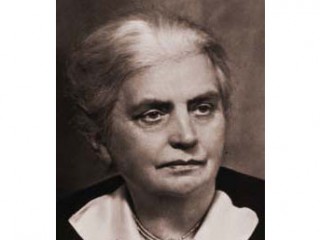
Eleanor Rathbone biography
Date of birth : 1872-05-12
Date of death : 1946-01-02
Birthplace : London, England
Nationality : British
Category : Politics
Last modified : 2011-03-22
Credited as : Politician, social reformer and author, Child Marriage: The Indian Minotaur
British politician and social reformer Eleanor Rathbone was one of the first women members of Parliament, known principally for her successful advocacy of family allowances.
Eleanor Florence Rathbone was born in London on May 12, 1872, into a family of social reformist politicians. Her father was William Rathbone, heir to a family tradition of political commitment and social responsibility and for many years a reformist member of Parliament. Her mother, Emily Acheson Lyle, raised ten children, the next to youngest of whom was Eleanor. Her childhood was alternately spent in Liverpool, where the Rathbone family was rooted, and London, where she attended Kensington High School.
She matriculated at Oxford (at Somerville College) in 1893 in the field of humanities and received second class honors in 1896. After graduation she intended to pursue studies in philosophy, but soon found herself more interested in the real social, economic, and political problems of the Liverpool environment.
One of the first issues that attracted her attention was the plight of widows under the existing Poor Law. Her investigations led her to realize the need for family allowances (or social security allotments for needy children in families whose income was insufficient to support them). Her first book on the subject was The Disinherited Family (1924), which became known as a classic introduction to the topic. In 1940 she published The Case for Family Allowances, and throughout her political life she continued to agitate for this reform. In 1945 her efforts were rewarded when legislation establishing family allowances was passed.
In 1909 she was elected as an independent to the Liverpool city council. In that capacity she concerned herself primarily with housing problems. During World War I she held an administrative position managing military separation allowances. At the same time she became active in the women's suffrage campaign, which achieved limited success in 1918 when British women over 30 were granted the right to vote. (It was not until 1928 that the age limit was reduced to 21, the same as for men). In 1919 she became president of the constitutional branch of the suffrage movement, which came to focus primarily on various legislative reforms pertaining to women's legal status and economic well-being. Her feminist interests were long-standing. In 1917 she contributed an article, "The Remuneration of Women's Services" to Victor Gollancz's The Making of Woman, and in 1936 she authored a piece for Rachel Conn Strachey's Our Freedom and Its Results, published by Virginia and Leonard Woolf's Hogarth Press.
In 1929 she ran successfully for Parliament (she had run unsuccessfully in 1922). She was elected as an independent representing the Combined English Universities, a position she held for nearly two decades. She claimed that her principal motivation for seeking office was her growing awareness of the unjust situation of women in other parts of the British commonwealth, particularly India. Thus, while she continued to be concerned with the interests of her university constituency, her primary focus from this point on was international. She worked intensely on extending Indian women's voting privileges and in 1934 published Child Marriage: The Indian Minotaur, an expose that led to legislative reform in this area.
During the 1930s she took a strong position to the British government's policy of "appeasing" German dictator Adolf Hitler in his quest for territorial aggrandizement. In 1937 she published War Can Be Averted, which condemned the appeasement policy, as well as the Italian invasion of Ethiopia (or Abyssinia) in 1935 and the failure of the Western democracies to help the leftist forces in the Spanish Civil War (1936-1939) against the fascists headed by Francisco Franco. (The abject policy of the democracies was called "non-intervention.")
After World War II broke out in 1939 Rathbone became increasingly concerned about the plight of refugees. She organized numerous relief programs and performed many acts of assistance to individuals. Her encounters with Jewish exiles led her to an awareness of Nazi atrocities against Jews. In 1943 she published a commission report documenting this persecution entitled Rescue the Perishing, and in 1944 she put out Falsehoods and Lies about the Jews. By the end of the war she had developed strong sympathy for the Zionist cause. (At that time Palestine was a British protectorate; the state of Israel was not proclaimed until May 1948.) Her own home in London was destroyed in the blitz.
Eleanor Rathbone died in London on January 2, 1946. She had left her mark as a tireless campaigner for social and economic justice and as a pioneer of women's participation in government.
















